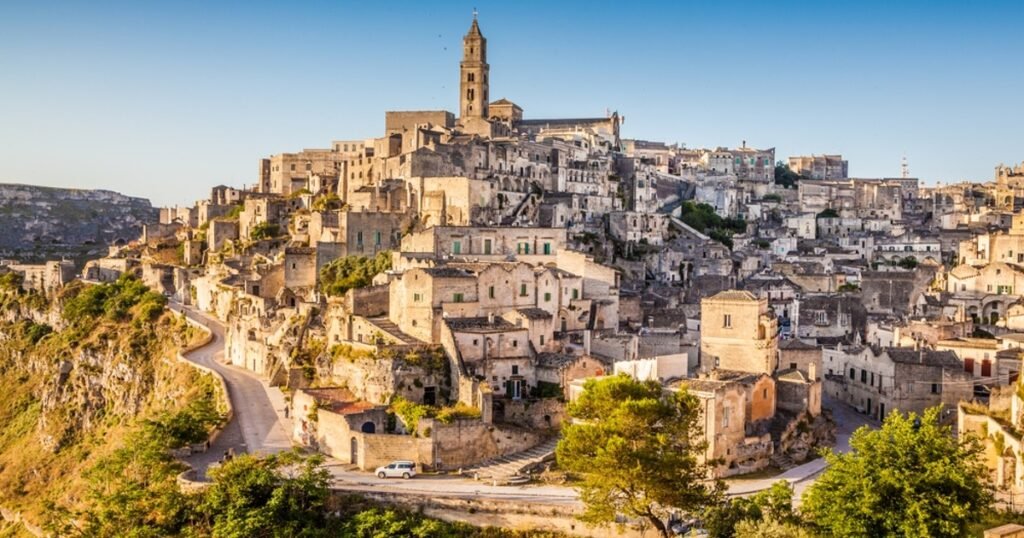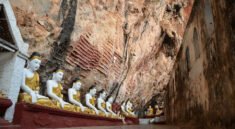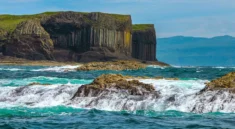
Nestled on a rocky outcrop in southern Italy’s Basilicata region, the city of Matera stands as one of the world’s most extraordinary urban settlements—a place where time collapses, and the boundary between ancient history and modern creativity blurs. At the heart of this surreal landscape is the Sassi District, a labyrinthine network of prehistoric cave dwellings carved into limestone cliffs, continuously inhabited for over 9,000 years.
Once considered the “shame of Italy” due to poverty and poor living conditions in the early 20th century, the Sassi has undergone a profound rebirth. Today, these caves have been transformed into luxurious boutique hotels, intimate artisan studios, cave restaurants, and cultural galleries. A visit here is not simply about seeing the past—it’s about living it, with every modern comfort nestled inside millennia-old rock.
Let’s wander the sunlit paths, candlelit caves, and artisan alleys of Matera’s Sassi—a UNESCO World Heritage site, a living museum, and one of Europe’s most magical destinations.
A City Carved From Stone: The Origins of the Sassi
The word Sassi means “stones,” but it refers to more than just geology. It encapsulates the Sasso Caveoso and Sasso Barisano, two ancient districts on opposing slopes of a ravine known as the Gravina di Matera. From a distance, the Sassi appear as a cascading honeycomb of cave homes, stone churches, and stairways clinging to the canyon walls.
Historians believe people began settling in the area during the Paleolithic period, making Matera one of the oldest continuously inhabited human settlements in the world. Over the centuries, the caves were enlarged, linked, and stacked to form a full-fledged city, complete with chapels, cisterns, bakeries, and even underground roads.
By the 1800s, thousands of residents still lived in these caves, but without running water or electricity, conditions deteriorated. The situation reached a critical point in the 1950s, prompting mass relocations. The Sassi were left largely abandoned—until a movement of restoration began in the late 1980s.
From Abandonment to Artistry: The Sassi’s Transformation
What was once a symbol of neglect has now become a beacon of cultural innovation and sustainable restoration. Visionary architects, hoteliers, and local artisans saw in the caves not ruin, but potential. With respect to the original stone architecture, the Sassi has been lovingly reborn.
- Boutique hotels and cave suites now offer luxurious stays with minimalistic design, vaulted ceilings, organic textures, and quietude unmatched by traditional cities.
- Artisan workshops have sprung up in repurposed cellars, from potters shaping clay the traditional way, to weavers, painters, and jewelers.
- Restaurants serve cuisine rooted in local tradition, featuring wood-fired ovens, stone-ground flour, and recipes handed down over generations—all in candlelit grottos or terraces overlooking the canyon.
The result is not a theme park or reconstruction—it is authentic living history, filtered through contemporary imagination.
Boutique Stays in the Sassi: Sleeping in History
One of the most unique features of Matera is the chance to spend the night in a cave—without sacrificing comfort. Hotels like Sextantio Le Grotte della Civita, Corte San Pietro, and Palazzotto Residence & Winery exemplify how luxury and history can co-exist.
Rooms are carved into the rock but outfitted with:
- Underfloor heating,
- Rain showers and soaking tubs,
- Natural stone and wood furnishings,
- Soft candlelight and panoramic terraces.
Guests often describe the experience as dreamlike, meditative, and grounding. The thick stone walls insulate you from noise and heat, making even the warmest days cool and peaceful inside. Some suites include former chapels or cisterns, now turned into yoga spaces, wine cellars, or quiet reading rooms.
Artisan Studios: Creativity Rooted in Stone
Wandering the winding alleys of the Sassi, you’ll find a thriving community of local artisans who have reclaimed the ancient caves not only as homes but as creative spaces.
- Ceramists work in caves where kilns once baked bread, using motifs inspired by Lucanian mythology and peasant symbols.
- Textile makers spin wool and linen using traditional looms.
- Painters and sculptors exhibit in dimly lit caverns turned galleries, their work a dialogue between past and present.
Visitors are often invited to watch the process, engage in conversation, or even join a short workshop to make their own souvenir. Unlike high street shops, here you buy with a story—and you leave with an object imbued with place, history, and human touch.
Cave Churches and Frescoes: Faith Etched in Rock
Matera is not only a secular marvel. It’s also home to over 150 rupestrian (rock-cut) churches, many hidden among the dwellings and visible only to those who seek them.
Some highlights include:
- Santa Maria de Idris: Carved into a giant boulder, this church merges into the cliffs and offers panoramic views of the Sassi.
- San Pietro Barisano: A larger cave church with subterranean chapels and burial niches.
- Crypt of the Original Sin: Located slightly outside town, this is Matera’s Sistine Chapel, with 9th-century frescoes in stunning condition, depicting Biblical scenes with Mediterranean artistic flair.
These churches were not just religious spaces—they were community centers, art studios, and shelters, giving insight into how the people of the Sassi wove their spiritual and daily lives into the same walls.
A Gastronomic Revival: Dining With Depth
Matera’s culinary scene reflects the region’s agricultural roots, infused with modern presentation. Ingredients are humble but elevated:
- Pane di Matera: A dense, rustic sourdough bread baked in wood-fired ovens, with Protected Geographical Indication (PGI) status.
- Cavatelli pasta with hearty ragù or wild greens.
- Pecorino cheese, olives, and local wines from nearby Aglianico grapes.
Dining in the Sassi often takes place in cave restaurants like Ristorante Francesca or La Lopa, where stone walls and flickering candles create a warm, intimate ambiance. Some meals are served in ancient wine presses or granaries, restored with care.
For the adventurous, al fresco cliffside dining offers stunning views of the ravine and churches bathed in golden light during sunset.
Walking the Sassi: A Living Labyrinth
Matera is a city for walkers. There are no cars inside the Sassi, only stone stairways, winding paths, and steep lanes—each corner revealing a new vista or hidden grotto.
Exploring without a map is part of the charm. Highlights include:
- Casa Noha, a multimedia museum inside a traditional cave dwelling that tells the story of Matera’s evolution.
- Belvedere Murgia Timone, across the canyon, offering postcard views of the entire Sassi, especially breathtaking at dusk.
- Museo della Civiltà Contadina, showcasing the tools, crafts, and domestic life of Matera’s pre-industrial era.
Every turn in the Sassi feels like walking through time, with layers of history embedded in the stone—Roman, Byzantine, medieval, and modern eras all converging in one place.
Cinema And Culture: Matera On The Big Screen
Matera’s otherworldly atmosphere has not gone unnoticed by filmmakers. The city has been a favorite stand-in for ancient Jerusalem and biblical lands. Films shot here include:
- Pier Paolo Pasolini’s “The Gospel According to St. Matthew” (1964)
- Mel Gibson’s “The Passion of the Christ” (2004)
- James Bond’s “No Time To Die” (2021)
In 2019, Matera was named a European Capital of Culture, which sparked further cultural revival—music festivals, exhibitions, and theatrical performances now regularly grace its stone stages.
Practical Tips: When and How to Visit
- Best Time: Spring (April–June) and autumn (September–October) offer pleasant weather and fewer crowds. Summers can be hot; winters are quiet and atmospheric.
- Getting There: The nearest major airport is Bari, about 1.5 hours away by car or shuttle. Trains and buses connect Matera with cities like Naples, Rome, and Lecce.
- What to Bring: Good walking shoes for uneven surfaces, sun protection, a flashlight for cave interiors, and a sense of wonder.
The Essence of Matera: Where Memory Lives On
Matera’s Sassi District is more than a backdrop—it is a living organism, pulsing with memory, creativity, and quiet resilience. It stands as a testament to human adaptation and imagination, where the ancient is not discarded but reimagined for the present.
To wander here is to feel the rhythm of chisel on stone, the silence of centuries past, and the warmth of hospitality rooted in hardship and hope. Whether you’re staying in a cave suite, sipping wine on a terrace, or watching an artisan shape clay beneath an arch of natural rock, you are not merely a visitor. You are a participant in a story still being written, one layer of stone at a time.




